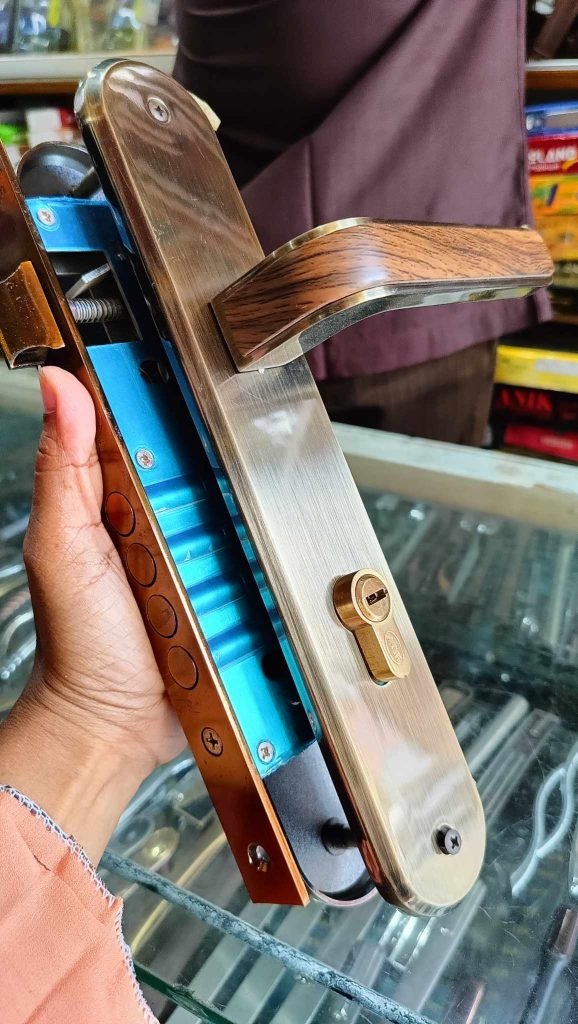
We fix doors, Call or Text me on: 07342914987
Local Business
No Call Out Fee
(See us on facebook)

DOOR REPAIR COOKRIDGE

Having trouble opening your home’s door? It’s frustrating, we know! This comprehensive guide covers everything you need to know to diagnose and address a wide range of door-related issues, whether they are creaky hinges, sticking locks, or damaged frames. Here’s everything you need to know about basic maintenance and repair.
Do you know how a door works?
In a defined space, a door provides entry and exit. In some cases, sliding doors open on tracks, while in others, hinged doors swing open. The majority of interior doors have hollow cores, while exterior doors are usually made of solid wood. In many cases, metal is used to make or cover fire doors. In some cases, glass doors with metal frames are used instead of wood doors. Some are made of vinyl, while others are made of fiberglass. Yet they are all operated and repaired similarly.

The most common problems and repairs for solid wood doors
As a natural product, solid wood doors can deteriorate over time, even though they are well-known for strength and durability. Various humidity levels, harsh weather, wear and tear and age all take a toll on objects. There are a number of common door problems that can be fixed yourself, fortunately.

Squeaky Hinges
Solid wood doors are prone to squeaks and creaks, which are one of the most annoying problems you may encounter. In addition to being easy to fix, they are also one of the most common. You can quiet down the noise by applying a little lubricant.

Aren’t you prepared? If you need to clean the hinge pins quickly, rub them with soap or a wax candle. You may have bent or misaligned hinges if lubrication does not stop the noise, or the noise returns quickly. You may need to replace the hinge if the hinge pin becomes stuck or is difficult to reinstall.
Sticky Door
The stubbornness of a door that sticks when you attempt to open it could be caused by two factors. Start by checking the hinges and edges of the door. Make sure the door is seated squarely inside the frame by running your hands around the gap between the door and the frame.

Make sure all the hinges are tight, and if any are gummy up with dirt, dust, or even old paint, a quick cleaning or light sanding should clear those up. Home | Cookridgehall
If the door is stuck at the top corner, then place a shim behind the bottom hinges (for example, a folded business card or piece of cardboard to start with). The door may need to be removed from the hinges, laid horizontally, and sanded or trimmed to remove the sticking edge if all else fails.

The door won’t latch
When a door refuses to close properly, the solution is often the same as for a sticky door described above – check the hinges. You might need to do a little DIY maintenance if they’ve worked loose. Avoid stripping the screws by being gentle when you adjust them.
Strike plate with a fault
A problem with the strike plate could also be the cause of your door not latching properly. If the door latch barrel is not aligned with the plate hole, it will not engage the door latch. Misalignments of a hair’s breadth are easily fixed.
The strike plate should be hammered back into place after you loosen the screws. To prevent future shifting, screw it tight. Remove and reposition the strike plate if it’s misaligned more severely.

Loose Screws
Some door problems can be caused by excessively loose screws in the hinge plates. You’ll have an off-kilter door that rubs against the frame of your door because it’s off-kilter instead of square. It feels very unsecure because the door itself shifts and rocks when opening and closing.
In order to resolve this issue, it is obvious that the screws need to be tightened. It is possible to replace them with longer screws if they spin freely in the hole. It might be possible to get the screws to bite into a wooden dowel, or cardboard rolled up covered in glue, by inserting them into the screw holes (and letting them dry). Door repairs by the experts at Door Repairs UK Ltd
Loose Handle
Unstable handles on interior or exterior doors can be dangerous when they become loose or wobbly. If it falls off completely, it can make it impossible to enter or trap someone inside a room.
As soon as possible, make sure all the screws are fastened securely into the door plate and the hazard is taken care of. Moreover, make sure any dirt or rust is removed. In addition, make sure that the lock is functioning properly.
Opened door does not stay open
Your door may be out of plumb if it keeps swinging shut on its own. The door and frame are tilted because the hinges are not properly aligned. You can bend a hinge pin by tapping the tip slightly with a hammer after you remove it from one of your hinges. In some cases, you may have to repeat this procedure with the other hinge pin.

The most common problems and repairs for uPVC Door
Owners of uPVC doors will encounter certain issues more often than others. In order to maintain the security of your property, we’ll discuss these uPVC door problems and how to fix them.
Locks that are misaligned
Even though uPVC doors aren’t unique in this regard, misaligned locks are the most common problem that owners encounter. Because the locking mechanism in the door does not match up to the doorframe, when the door locks become misaligned, locking or unlocking the door becomes difficult.
In some cases, this can be caused by the door naturally aligning itself as a result of general wear and tear, or as a result of fluctuating weather conditions.
How to fix it
If the lock does not meet the doorframe, loosen the screws and move the doorframe into the appropriate position (using a screwdriver or an allen key). Getting the right fit may require multiple attempts. Retighten it once you’re satisfied with the position. If you prefer, you can have the locks realigned by your local locksmith.
Breaking of locks due to pressure
Because of the pressure put through locks with regular use, they may weaken or break over time. In this case, you would be left with either a locked or an unlocked door, neither of which is beneficial to you.
How to fix it
The locks in your door will last longer if they are kept lubricated with WD40 or similar products. The pressure placed on the locking mechanisms can also be reduced by avoiding excessive force when raising the handle. As a result, your locks will remain stronger for a longer period of time.
Locks that are easily manipulated
A typical lock on a uPVC door can be tampered with easily since they are inexpensive. If someone breaks into your home, you may need to replace expensive items in your home in order to keep the cost of the door down.
How to fix it
If you want to reduce the likelihood of an intruder getting into your uPVC doors, consider upgrading the locks. Intruders may also be deterred by additional security measures such as bolts or chains on your door.

The problems and solutions of composite door
Door Locking mechanisms
A damaged door locking mechanism causes most issues with composite doors. It may be difficult or impossible to lock the door or even close it properly if one part of the mechanism is defective, leading to sticky locks that prevent the door from being used.
Composite door locks are available in a variety of types, but the most common are mortise locks, euro cylinders, and night latches. It’s simple to remove the lock from its frame by finding the screws that hold it in place and unscrewing them carefully.
How to fix it
The locking mechanism needs to be lubricated and adjusted if the door is sticking. Cleaning the mechanism with a soft cloth should be the first step. Make sure that all the moving parts are lubricated. Other alternatives can cause additional damage, so use a product specifically designed for locks and doors.
If the lock does not move smoothly and without resistance after the lubricant is applied, try operating it several times. The latch and deadbolt may need to be adjusted if there are still issues. It may be necessary to replace some or all of your composite door’s components if all else fails.
Composite door cracked
The composite door may crack over time, especially if it is an exterior door. Changing temperatures or sudden impacts can cause this. It is common for uPVC doors to crack, but composite doors are also susceptible to cracking.
How to fix it
Depending on the severity of the crack, the solution may vary. Using a composite repair kit or epoxy putty can fix a small crack if it’s only a small crack.
In the case of an extensive crack, the entire door may need to be replaced for safety reasons. Prior to attempting any repairs, get in touch with an expert in order to avoid further damage to your door.
Swelling, warping, or bowing of composite doors
Changes in temperature or humidity can lead to warping, bowing, or swelling of composite doors. A gap in the frame can hinder door opening and closing.
How to fix it
A hinge adjustment on the door frame is the best solution for this problem. Install new screws that are slightly longer after removing the old ones from the hinges. This should prevent the door from warping or bowing and help create a tighter fit. Additional weather stripping may be required if gaps still exist after adjusting the hinges.
Hinges dropped
The door can become misaligned if the composite door hinge drops. In this case, the door may not be able to be opened and closed properly.
How to fix it
Adjusting the hinge screws on the door frame is the best way to fix this. Before installing longer screws, loosen all existing screws. As a result, the hinge will be lifted back into place. If there are still gaps around the edges of the door after tightening up the screws, you may also need to add additional weather stripping.
A worn-out weather seal
In addition to worn weather seals, composite doors are often prone to rust stains, particularly in cases of frequent wear and tear. Consequently, drafts or rainwater may be able to enter the house through gaps around the door frame.
How to fix it
A composite door weather seal will solve this problem the best way. Replace the existing one with one designed for composite doors. Before purchasing one, make sure that it is the right size for your door, which can be found in most hardware stores and online retailers. The correct seal should be installed on the door frame, then secured with adhesive.
Hire professionals for Door Repair Cookridge
Whether you have wooden, uPVC, or composite doors in Cookridge that need to be repaired, our team of skilled professionals can help. As well as improving the overall aesthetics of your home, it is important to have secure and functional doors. From traditional wooden doors that exude warmth to modern uPVC and composite doors that are known for their durability, our experts specialize in repairing all types of doors.
No matter what the issue is, from a squeaky hinge to a misaligned frame to a draft, our experts have the know-how to assess the issue and provide an effective solution. By entrusting its repair to our capable hands, you can enjoy the peace of mind that comes with a well-maintained and properly working door. The security of your Cookridge home and your satisfaction are our top priorities.

You will find all the information and guidance you need in this guide to make sure your wooden, uPVC, or composite doors remain in good shape. We’re dedicated to addressing any issues your doors might be experiencing, from minor inconveniences to more significant concerns. When you choose our door repair Cookridge services, you’re choosing peace of mind and assurance that your home is well taken care of in terms of security and aesthetics.